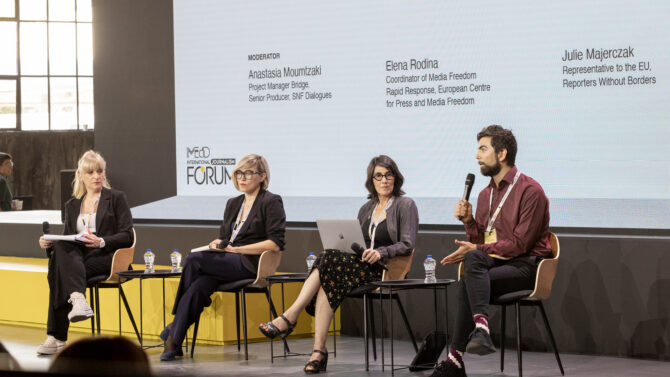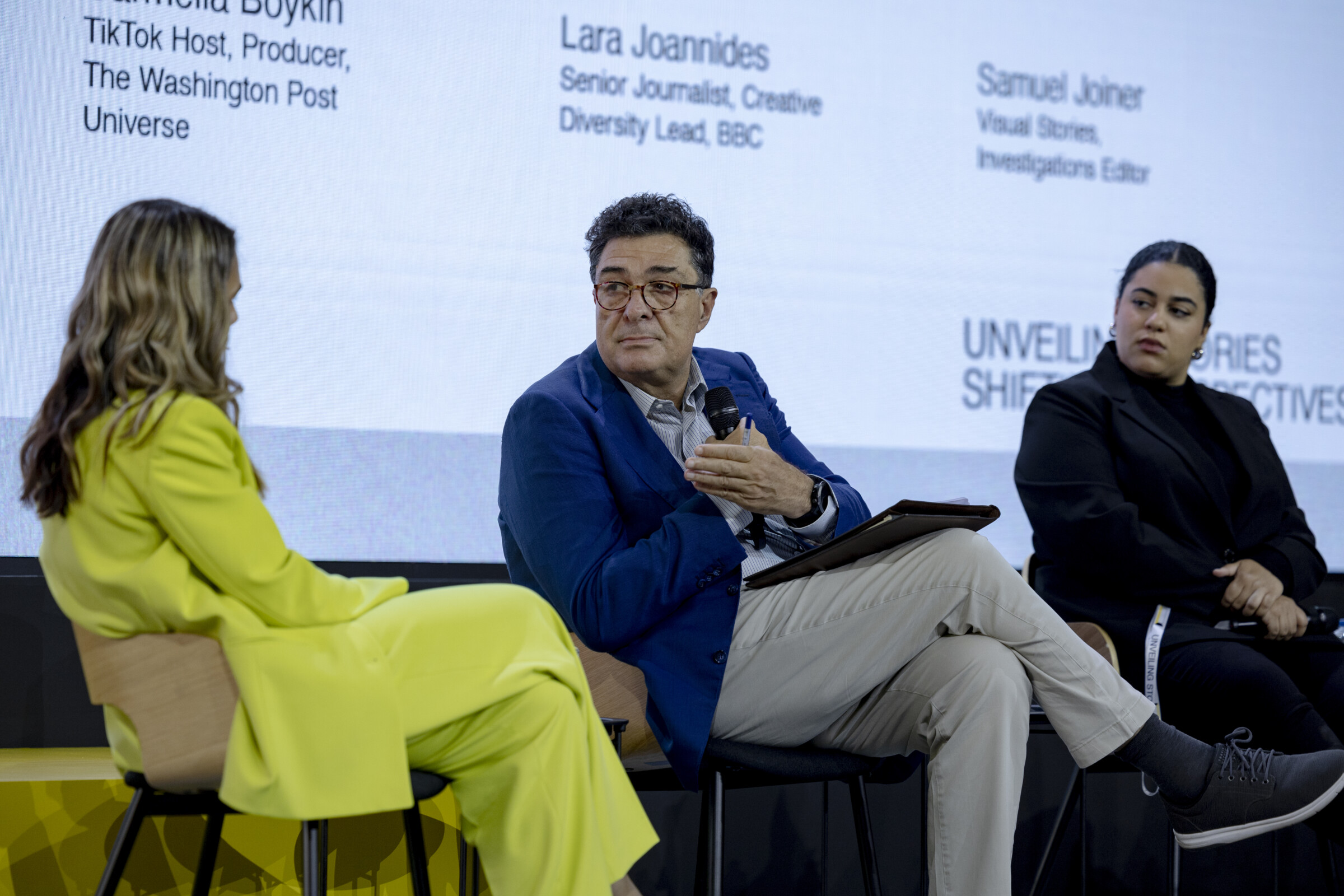Can public trust in the media be restored? What kinds of content make investigative journalism more accessible? Can broader representation of social groups help reverse news avoidance? Elli Petraki, a second-year journalism student at the National and Kapodistrian University of Athens, noted the innovative solutions that four journalists – with different perspectives from each other – proposed to combat news avoidance.
Press Freedom in Europe: Challenges, interventions, and perspectives

Why are European journalists increasingly concerned about press freedom? What challenges do they face? Agapi Pachatouridou, a second-year student in the Department of Communication and Media Studies at the National and Kapodistrian University of Athens, highlighted key insights from the opening panel at the iMEdD International Journalism Forum 2024.
On Friday, September 27, the main hall of the iMEdD International Journalism Forum on 260 Pireos Street was packed. The panel, titled “‘It’s Not Me, It’s the News’: Addressing news avoidance,” began with moderator Katerina Eva Matsa, Director of News and Information Research at the Pew Research Center, setting the stage for the upcoming discussion on the phenomenon of news avoidance.
Ms. Matsa noted that news consumption is declining in the U.S. and globally. She highlighted that 62% of Americans report feeling overwhelmed by the amount of news, particularly around the presidential election. The public, she explained, is largely informed “online and accidentally” through social media. At the same time, she pointed out that polarization is increasing, and there is rising skepticism towards traditional media. She also mentioned that people under 40 trust social media almost as much as they trust journalistic organizations. Notably, 52% of TikTok users get their news exclusively through the platform. In concluding her remarks, Ms. Matsa emphasized that the public’s drift away from the news is tied to a lack of trust in the media and to the media’s failure to represent a wider array of social groups.

The future of traditional journalism
Alexis Papahelas, Executive Editor at Kathimerini newspaper, who was the first to speak, representing the legacy media, attributed news avoidance to several factors. He explained that one major cause is the public’s reaction to elites. “My interpretation is that there is a reaction towards legacy media, establishment media (…) People think we are part of the system, and therefore, somehow, we don’t give them the whole truth, which I don’t buy, but this is a perception. And I think these people go to social media thinking that’s where the truth is,” he noted. Papahelas expressed confidence that the public could return to traditional journalism if certain new techniques were adopted. He emphasized that the solution does not lie in divisive headlines or extreme opinions. “If we lose traditional media, democracy is going to suffer,” he warned. Of course, this does not mean that Kathimerini will stop evolving. The newspaper, he said, has embraced several creative ideas to meet the demands of the times, most notably by covering stories outside Athens—stories that resonate more closely with the public.
Attracting Gen Z
From a Gen Z perspective, Carmella Boykin, a TikTok host and producer at The Washington Post Universe, noted that young people have become disenchanted with news due to its negative content. She explained that in today’s demanding daily lives, news often adds to stress and fear. Ms. Boykin creates short, vertical videos that engage audiences through humor to address this. “I am constantly asking (…) how can I get people to want to know more about these certain topics? By giving them information that they might not be consuming. So, by putting it on social media platforms where people are getting cute dog videos and baby videos. And then also they’re getting a bit of the news as well.” She explained that content creation is an ever-evolving process that wouldn’t be possible without the reporting of investigative journalists at The Washington Post. While information can be presented creatively, the key requirement is accuracy, as she stressed. In writing each script, she noted that she always considers what essential facts can be conveyed to reach someone who knows nothing about the subject.

People think we are part of the system, and therefore, somehow, we don’t give them the whole truth, which I don’t buy, but this is a perception. And I think these people go to the social media thinking that’s where the truth is.
Alexis Papahelas, Executive Editor at Kathimerini newspaper
Focus on inclusion and equal representation
Lara Joannides, a senior journalist and creative diversity lead at the BBC, addressed the issue of representation as a significant factor in news avoidance. “For us, whether it’s TikTok, social media, long-reads, all of the different things we do, we have to make sure that we have really authentic storytelling that is reaching so many different communities and life experiences, which is a really big task but it is something that is not just a legal obligation for us as a public service organization but a moral obligation,” she stated. Joannides emphasized that covering authentic human stories that resonate with different groups in society could help combat news avoidance. In this process, it is not only important who is being portrayed, but also which stories are published, who takes them on, and how they are developed, she mentioned. Representation extends beyond journalists to include everyone involved in the news production process. While it’s clear that all voices should be represented, there are still skeptics and cynics who require quantitative data to appreciate the significance of a story. She also shared findings from BBC reports indicating that the public recognizes and values the push for inclusion, even though there is still much work to be done to achieve true equality.
Adaptation to public preferences
Samuel Joiner, visual stories and investigations editor at the Financial Times noted that audiences—who consume news on mobile devices anyway—prefer to engage with other apps, which they find more entertaining, rather than news apps. “Formats are a great way to change that. (…) Most media organizations have headline-picture-text. That’s how we deliver the news. We have to be way more creative in the way we send out information,” he explained. He suggested using visuals to make the news more understandable and engaging, whether it’s a feature story or an investigative report. Joiner argued that this approach aligns with how the public consumes information, especially given their limited time and attention spans.

AI: Opportunities and risks
The conversation concluded with Ms. Matsa posing a question to all the speakers about the role of artificial intelligence (AI) in journalism, referencing Mr. Papahelas’s assertion that “Western democracies lost the first battle in terms of misinformation with the algorithms.” Mr. Joiner responded by highlighting that AI could benefit journalistic media. “I think the biggest challenge is people turning to chat GPT to get information directly,” he noted. He emphasized that for media outlets to convince audiences that they are providing the information they seek, they will need to improve and adapt to new data.
Ms. Joannides responded to the question from a diversity and inclusion perspective, stating that the primary issue is the inherent biases in the models upon which AI is based. Until these biases are addressed, she believes journalists should exercise caution in using AI tools. Finally, Ms. Boykin noted that the challenge for journalists is distinguishing between the misinformation generated by AI and convincing the audience of the credibility of the information they present.
You can re-watch the discussion here.
Check out all Pop-Up Newsroom 2024 stories here.